The Dendrobium Orchid (Dendrobium), a member of the Orchidaceae family, is a stunning perennial plant native to the tropical and subtropical regions of Asia, the Pacific, and New Zealand. Known for its epiphytic nature, this orchid thrives in warm climates and is suited for hardiness zones 9, 10, and 11.
Whether you’re considering adding a Dendrobium Orchid to your indoor collection or outdoor garden, its captivating blooms can be a rewarding addition with the right care. In this guide, we’ll cover essential tips for growing and maintaining these elegant orchids, ensuring they thrive and flourish.
| Common name | Orchid |
| Botanical name | Dendrobium |
| Family | Orchidaceae |
| Origin | Tropical and Subtropical Asia to the Pacific and New Zealand |
| Life cycle | Perennial |
| Plant type | Epiphyte |
| Hardiness zone | 9, 10, 11 |
| Sunlight | Dappled Sunlight |
| Maintenance | High |
| Soil condition | High Organic Matter |
| Drainage | Well-Drained |
| Height | 6 in. – 4 ft. |
| Flower color | Brown, Copper |
| Leaf color | Green |
| Fruit color | Brown, Copper |
| Stem color | Green |
| Flower benefit | Fragrant |
| Garden style | Asian Garden |
| Uses | Container |
I. Appearance and Characteristics
Dendrobium is a genus of mostly epiphytic and lithophytic orchids in the family Orchidaceae. It is a very large genus, containing more than 1,800 species that are found in diverse habitats throughout much of south, east and southeast Asia, including China, Japan, India, the Philippines, Indonesia, Australia, New Guinea, Vietnam and many of the islands of the Pacific.
The genus Dendrobium was first formally described in 1799 by Olof Swartz and the description was published in Nova Acta Regiae Societatis Scientiarum Upsaliensis. The name Dendrobium is derived from the ancient Greek words dendron meaning “tree” and bios meaning “life”, referring to the epiphytic habit of most species.
In 1981, Friedrich Brieger reclassified all terete-leaved dendrobiums from Australia and New Guinea into a new genus, Dockrillia and in 2002 David Jones and Mark Clements separated the genus into smaller genera, including Thelychiton, Tropilis, Vappodes and Winika but all of these genera are regarded as synonyms by the World Checklist of Selected Plant Families.
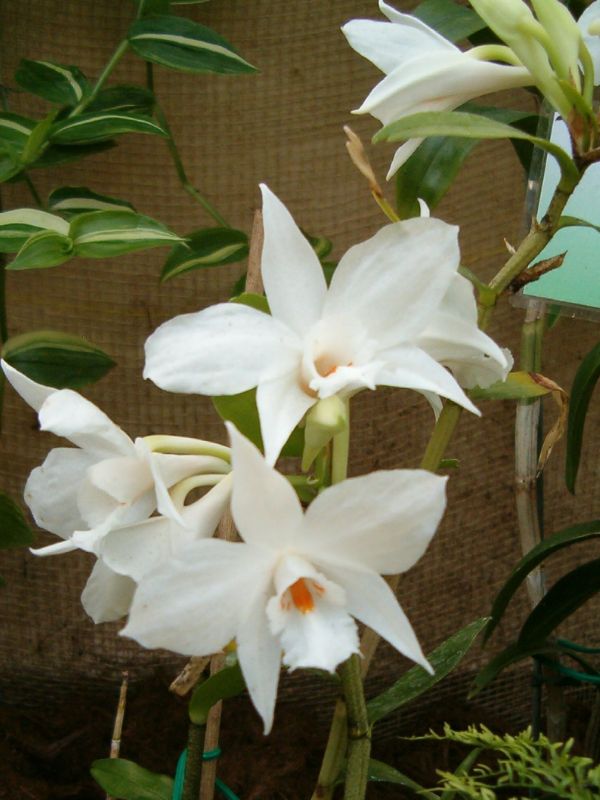
Dendrobium species are mostly epiphytic, or lithophytic although a few species are terrestrial. They are sympodial herbs with cylindrical roots usually arising from the base of a pseudobulb. The pseudobulbs, when present, are hard, sometimes cane-like, cylindrical or cone-shaped and more or less covered with the bases of the leaves. There are from one to many leaves arranged in two ranks, the leaves varying in shape from linear to oblong, sometimes cylindrical but never channelled or grooved. They are usually much longer than wide and last for only a single season.
Between one and a large number of resupinate or non-resupinate flowers are arranged along an unbranched flowering stem and may be short or long-lived. The flowers may be white, green, yellow, or pink to purple, often with contrasting colours in the labellum. The sepals and petals are usually free from and more or less similar to each other but markedly different from the labellum. The labellum is more or less egg-shaped, with the narrower end towards the base and flanks the column. There is often a callus consisting of narrow, parallel ridges, in the centre of the labellum.
II. How to Grow and Care
Sunlight
Select your brightest window—preferably a south-facing window—for the orchid to bloom well. The appearance of many tiny offshoot plants (known as keikis, pronounced “kay-keys”) on relatively young, small canes can mean the plant isn’t getting enough light.
On the other hand, if you see yellow leaves, you might have given the plant too much direct sunlight.
Temperature and Humidity
Keep Dendrobium orchids warm with daytime temperatures between 70°F and 85°F , with a nighttime drop of about 10°F.
Many types require a winter rest period where the plant is kept at about 55°F for several weeks to prompt reblooming.
Dendrobiums prefer a humidity level between 50 and 70 percent (with a minimum of 45 percent). Brown leaf tips can be a sign that the air is too dry for your orchid.
Watering
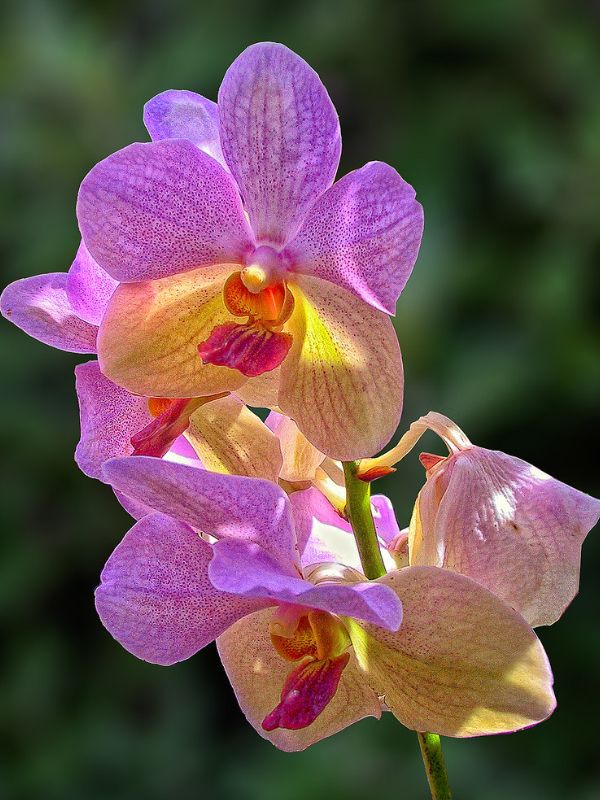
Watering is most crucial during the growing season and you should use distilled water or rainwater to prevent minerals and salts from building up in the pot. To determine when you should water, simply stick your finger in the medium.
If it feels wet, wait to water until it has dried out slightly. During the winter months, you can put a few more days in between your regular waterings, but don’t let the medium dry out entirely. Overwatering can lead to root rot and ultimately cause the plant to yellow or wilt.
Soil
Purchase a special orchid growing mixture when potting or repotting that mimics their environment in the wild. Make sure the medium has aeration and is well-draining, so the roots aren’t left in too much moisture for a lengthy period.
Fertilizing
Feed the orchid regularly during the growing season with a balanced orchid fertilizer, following label instructions. At the end of the growing season, reduce fertilizer by about half.
Pruning
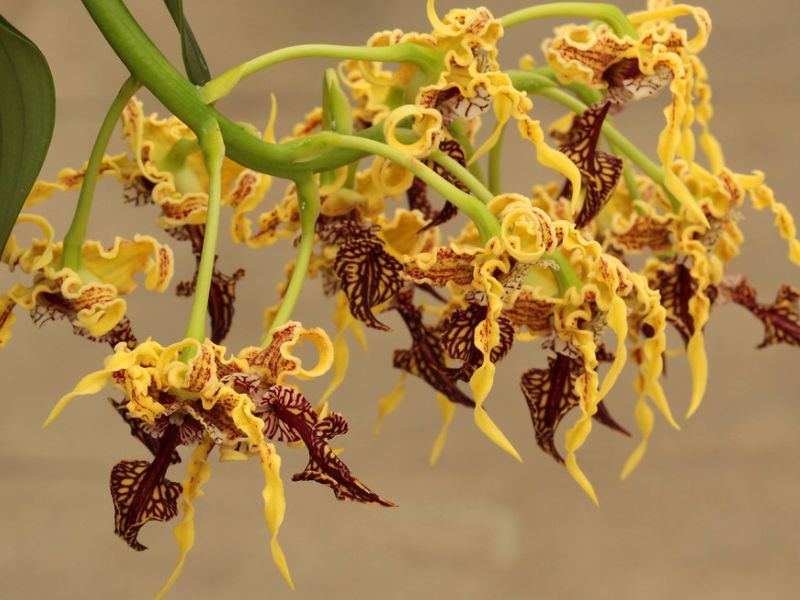
These plants generally send up at least one new upright cane each year. After the flowers fade, they can be clipped off where they join the canes, but don’t cut off old canes, as they store nutrients and water to keep the orchid healthy.
Clipping this stem off does not promote reblooming, as it does with some other types of orchids.
Old canes also will sometimes flower or produce tiny offset plants, called keikis, that can be potted on their own after they develop roots.
Propagation
If your plant has at least four canes bearing healthy leaves, you can divide it. Here’s how:
- Use a large stiff knife to cut through the rhizome and root mass, attempting to keep the root mass as intact as possible.
- Remove all the growing medium from the root mass, and then cut away any long dangling or dead roots.
- Put the plant in a pot close to the size of its root mass, and cover the roots with an orchid potting medium.
- Press down the potting medium firmly, and wait one week to water it thoroughly.
How to Grow From Seed
Seed propagation of orchids is not recommended, since it requires carefully controlled conditions and laboratory precision. In the wild, orchid seeds germinate through a complex symbiotic relationship with soil fungi, and duplicating this process artificially is tricky and prone to failure when attempted by amateurs.
Potting and Repotting
Dendrobiums grow well in any well-draining container filled with commercial orchid potting mix, which is usually a bark-based medium. Repotting is usually needed every two to three years and is best done in the spring.
Repotting is needed if the plant outgrows its pot, or if the plant has broken down the potting mix. Choose a pot large enough to accept four to six new canes, then slide the plant out of its old pot, rinse off the root ball, and plant in the new pot with fresh bark-based potting mix, spreading out the roots as you fill the pot.3
Overwintering
Proper overwintering strategy can vary somewhat depending on species, but generally speaking, dendrobiums should be given a cooler, drier, rest period during the winter. Three or four weeks spent at 55°F is often ideal, before returning them to the normal pattern of 60°F to 65°F nights and 75°F to 85°F days.
Pests and Diseases
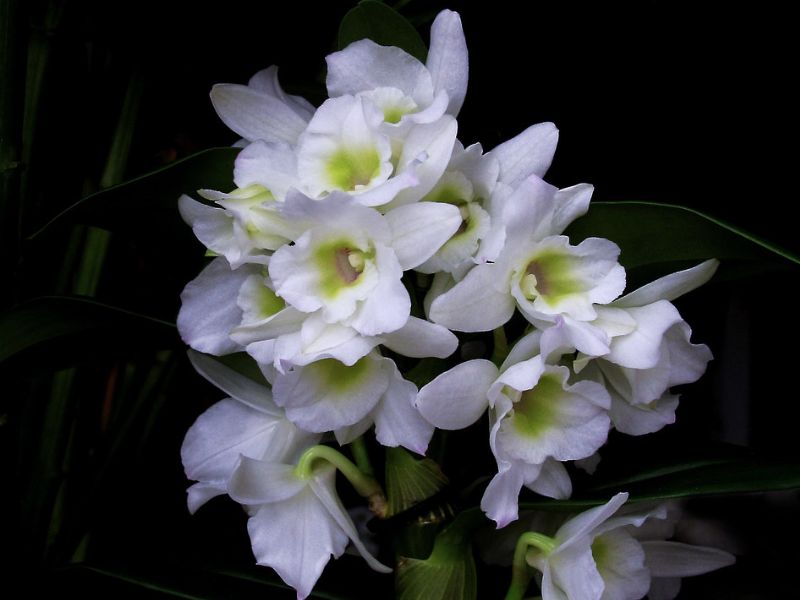
Common Pests & Plant Diseases
Mealybugs are the most common pest for dendrobium orchids, often hiding in the junction where leaves meet the canes. A good treatment is to spray with a homemade concoction consisting of equal parts water and rubbing alcohol, with a few drops of dish soap added. Large infestations may require spraying with a commercial pesticide formulated for houseplants.
Diseases are not common with dendrobiums, but excessive watering may cause root rot. Petal blight, a fungal disease, can sometimes cause spotting on the flower petals. Affected blossoms should be removed.
Common Problems
Dendrobiums are regarded as one of the easier orchids to grow, but you may run across these issues:
Yellowing, Spotted Leaves
Too much water can cause yellowing leaves, but with some deciduous species, it is natural for leaves to develop spots and turn yellow just before they are shed for the winter.
Burned and Brown Leaves
Browned edges on leaves can be caused by too much fertilizer or by growing medium that has become saturated with salts and minerals from tap water. Most likely, though, is sun scald caused by too much exposure to direct sunlight.
If these plants are kept in south- or west-facing windows, it is a good idea to use a sheer white curtain during the summer months to diffuse the sunlight. Dendrobium orchids will tolerate partial shade and some direct sun, but bright indirect light is better.
Low humidity can also cause leaves to dry up and turn brown.
III. Uses and Benefits
- Use in horticulture
Dendrobium is abbreviated as Den. by the Royal Horticultural Society. Some species are in great demand by orchid lovers. This has resulted in numerous varieties and hybrids, such as the noble dendrobium (Den. nobile) breeds, which have greatly extended the range of colors of the original plant from the Himalayas. The flowers of Cuthbertson’s dendrobium (Den. cuthbertsonii) have been reported to last up to ten months each.
Many Dendrobium species are known to vigorously remove toluene and xylene from the air.
- Medicinal uses
Some Dendrobium species are cultivated as medicinal plants. The noble dendrobium (D. nobile) for example is one of the 50 fundamental herbs used in traditional Chinese medicine, where it is known as shí hú (石斛) or shí hú lán (石斛兰).
The 1889 book ‘The Useful Native Plants of Australia records that Dendrobium canaliculatum was called “yamberin” by the Indigenous People of Queensland, Australia and that “The bulbous stems, after being deprived of the old leaves are edible (Thozet).”
IV. Types of Dendrobium Orchids
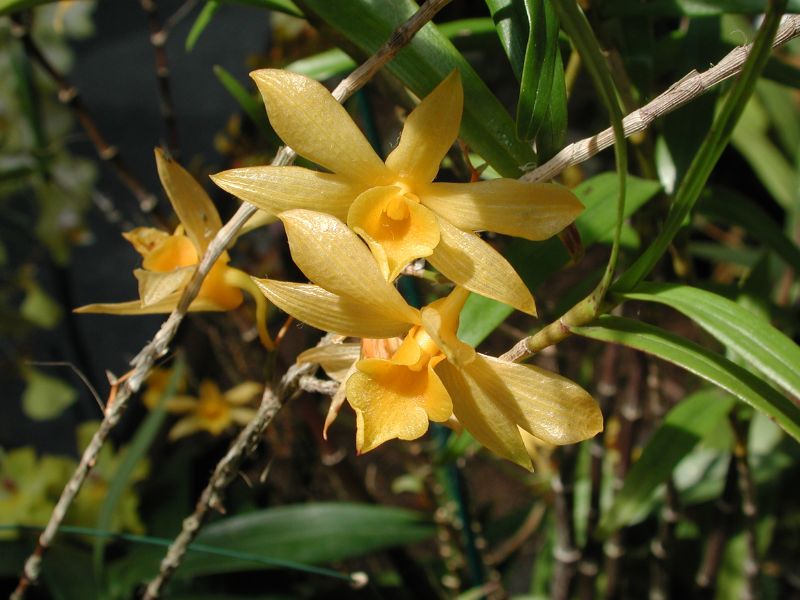
Dendrobium orchids are classified into six distinct groups with different characteristics and care needs. It is important to understand what group your orchid falls into so you can give it proper care:
- Dendrobium phalaenopsis comprises most of the commercial dendrobiums offered for sale. These evergreen species usually bloom in the fall, with a spring rebloom possible if the plant is given a three- to four-week rest period at lower temperatures and drier conditions.
- Dendrobium spatulata blooms several times a year and does not require the winter rest period to rebloom. These orchids are identified by their spiral, twisted, and curly-edged floral segments and asymmetrical flowers.
- Dendrobium is divided into two sections. Group One species actively flower in summer, drop their leaves in winter, and require a cool, drier winter rest period. Species in this group include D. chrysanthum, D. friedricksianum, and D. nobile.
- Group Two species are fully deciduous and should not be watered at all in winter. Species include D. crassinode, D. falconeri, D. loddigesii, and D. transparens.
- Callista orchids have bright colors and canes with dense blooms. Species include D. aggregatum, D. farmeri, and D. thyrsiflorum. They need warm conditions in summer but reduced temperatures and drier conditions in winter.
- Latouria orchids are characterized by large yellow-green blooms that have black or purple markings on the inside surface of the petals. Species include D. atroviolaceum, D. macrophyllum, and D. spectabile.
- Formosae orchids have fine black hair covering the canes. Species include D. bellatulum, D. draconis, and D. sanderae. These plants require cool to moderate conditions year-round: 50- to 60-degree nights and days that are no more than 85°F .
Find Where to Buy the Best Orchid (Dendrobium)






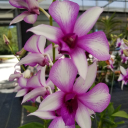











Leave a Reply